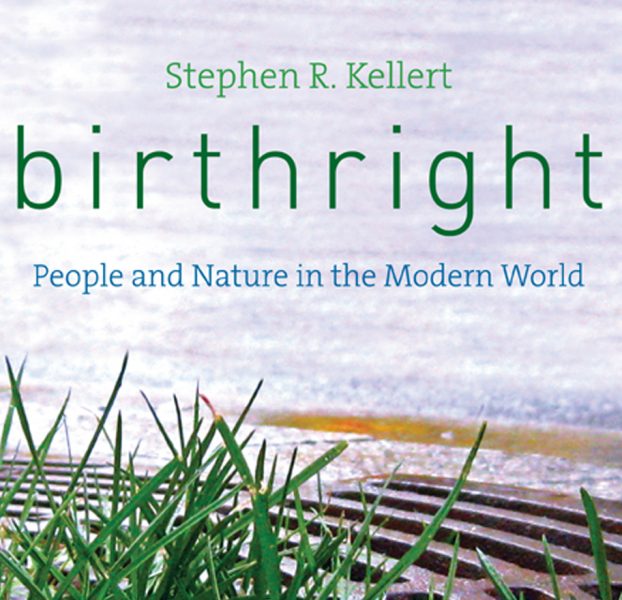The Human-Nature Birthright
Read more about Birthright on Facebook
In our urban, tech-savvy world, our contact to the natural world vastly declines as we leave childhood behind and enter the “real world.” But nature is our lifelong companion, a part of our real world, even though it may escape our notice. In Stephen R. Kellert’s new book Birthright: People and Nature in the Modern World, he reminds us that we humans are dependent on nature now more than ever.
 There is an implicit assumption in today’s society that innovation and advances entail conquering nature and manipulating it for our own benefit. We grow genetically modified crops, spay and neuter animals, and trying to our hardest to kill off weeds and pests. But we tend to forget that nature, intransigent as it may be, is still our primary resource. Bees may be annoying bugs with painful stingers, but bees influence our economy more than you would think. As pollinators they are responsible for about 33% of all agricultural production, and as honey makers they generate a billion-dollar international trade market.
There is an implicit assumption in today’s society that innovation and advances entail conquering nature and manipulating it for our own benefit. We grow genetically modified crops, spay and neuter animals, and trying to our hardest to kill off weeds and pests. But we tend to forget that nature, intransigent as it may be, is still our primary resource. Bees may be annoying bugs with painful stingers, but bees influence our economy more than you would think. As pollinators they are responsible for about 33% of all agricultural production, and as honey makers they generate a billion-dollar international trade market.
Our current material dependence on wild plants and animals is said to account for 15% of the global economy. Thanks to modern-day packaging and product marketing, however, most people view modern medicine as a man-made product of laboratory science. But between ⅓ to ½ of all the pharmaceuticals we use derive from a wild plant, animal, or microorganism, and a similar claim can be made about food. With the prevalence of frozen and processed foods, our lack of “source knowledge” has obscured the fact that food and agriculture are products of nature rather than of human invention.
We may forget that nature is a resource for our physical well-being, but we also fail to remember how nature can greatly boost our mental health. Kellert points out that exposure to nature can provide immense benefits to our emotional welfare. A key concern, however, is that the majority of today’s world lives in an urban or suburban environment and spends 90% of the time indoors. But even in the most metropolitan setting, we can still manage to incorporate nature into our everyday lives. People may think that connecting with nature means secluding oneself in the woods like Thoreau, but simply purchasing a plant or landscape painting for your office can provide subtle benefits. Consider, then, how that fish tank at the dentist’s office may be helping you more than you know.
A balanced relationship with nature is not only beneficial for adults, it is also necessary for children. Trips to the zoo and afternoon playtime in the park are more than just sources of entertainment for children; they are also tools for intellectual development. Children are constantly challenged in nature, which in turn builds character. Their constant exposure to foreign creatures will always stimulate their imagination and curiosity and also hone their thinking skills. But at present children spend about 52 hours a week facing a digital monitor and only about 40 minutes outside. The natural world, not the computer, remains the most sensory-stimulating and information-rich environment people ever encounter. Nature plays a key role in childhood; many of our most powerful memories and stories take place in nature, and almost 90% of the characters in young children’s books are drawn from the natural world (remember Winnie the Pooh and Peter Rabbit?).
Even though we live in the Information Age, our knowledge of nature is quite low. Our generation today has individuals who are indoors for days at a time, programming the most advanced technological devices and programs. But those individuals may be completely incapable of determining which plants in their neighborhood are edible and which are poisonous. Meanwhile Kellert highlights two non-Western communities, the Koyukan of the North American Arctic and the Foré of Papua New Guinea, who lead simpler lifestyles but have an extensive knowledge and precise understanding of their respective region’s ecology. That Western society can be so far behind “primitive” societies in terms of ecological expertise and awareness invites us to reconsider our assumptions about what makes a society developed and civilized.
We may not think we need nature, but even our man-made creations are nature-inspired. Architectural wonders like Chartres cathedral in France, the Sydney Opera House in Australian, and the TWA terminal at John F. Kennedy Airport in New York City are designed with patterns that are found in nature. And buildings that elements of biophilic design (natural light and ventilation, plants, natural views, and spaciousness) create more productive and healthy environments for workers.
Kellert supplements interesting data and facts with poignant stories, narrative interludes, some of which are fictional while others are autobiographical. Though the stories are about other people, one cannot help but identify with the characters and appreciate how nature affects them in so many wonderful yet inexplicable ways. This book reminds the reader to take advantage of nature’s eternal helping hand; sometimes one needs to sit in an open space with light, air, and verdure and breathe deeply.




